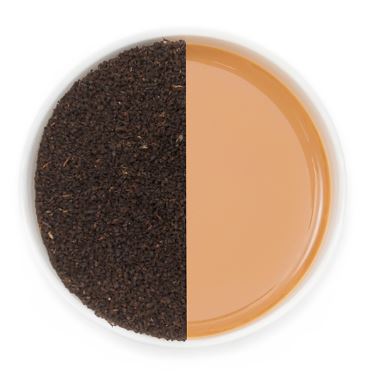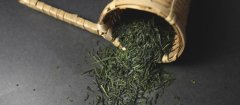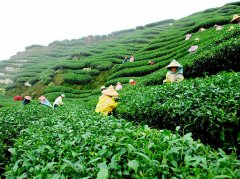How is tea made? what are the tastes and characteristics of Darjeeling black tea?
Darjeeling Tea is an orthodox black tea because Darjeeling tea leaves are withered, rolled, fermented and dried in traditional ways.
Today, orthodoxy means top tea picked by hand and processed by hand.
However, at present, more than 90% of the black tea in the world is produced by CTC (cut shredding, tear tearing, curl rolling).
In the middle of the 20th century, as tea bags became popular all over the world, a new processing method was developed to put finely broken tea into small tea bags and brew rich tea more quickly, and it is convenient and fast.
CTC is the source of the name of this brewing drink.

Orthodox rolling of tea leaves, while factory machines use blades to cut broken tea leaves at different speeds. Resulting in chocolate brown granular tea, average size and pebble-shaped, completely different from the slender fruit of orthodox tea.
Although CTC tea is easy to produce and cheap, it lacks different levels of flavor.
Tea tasters pursue color and concentration, which is often said in the industry as a good soup Good Liquoring.
The best way to evaluate the tea is to add a drop of milk to the cup of tea, which is good tea if you turn the cup of tea into a plain grayish brown before the drop of milk is dispersed in the dark tea.
Unlike the tea produced in other Indian countries, Darjeeling Tea's beauty can make you float and experience another wonderful place.
History of Indian Tea
Although India is a country that drinks tea, it is not so since ancient times. Indians have not had a long history of drinking tea.
When India became independent from Britain in 1947, India produced only 51 million kilograms of tea, or 20% of the total output of 152 million kilograms, for domestic consumption.
According to Chronology, the website of the Indian Tea Association, Indian tea drinks are related to the British Empire.
It was once considered harmful to human health in the country. Gandhi wrote in key to Health Key to Health that tannins are commonly used in tanneries to harden the skin. When taken by the human body, it produces a similar effect on the mucosal walls of the stomach and small intestine. This can damage jokes and lead to indigestion.
It was not until the 1960s, with the advent of the more popular CTC tea, which was suitable to be paired with milk, sugar and even spices, that roadside tea stalls sprang up in India. Tea became a symbol of both India and Britain.

Today, about 800 million kilograms of tea, or 80% of India's total tea production, is supplied to the local market, a 15-fold increase since the country's independence.
Darjeeling Tea exports about 3/4 to about 43 countries. Darjeeling Tea can be found in some high-end tea suppliers, high-end restaurants and hotels.
But today, Darjeeling's estate is built on a shaky agricultural system.
A kilogram of Darjeeling Tea needs to be manually selected and picked 22, 000 buds to be made, and a kilogram of tea can be sold for months' wages. The rate of absenteeism among workers is also increasing, and people want to go out of the manor to work for big companies in the city, or to work as domestic helpers.
In addition, regional separatism destabilized the local situation, and at one point, weeks-long protests led to the closure of the mountains to promote the independent state movement.
Climate change in recent years has also added many uncertainties, monsoons have become more intense and unpredictable, the region often suffers from prolonged droughts and temperatures are rising.
Important Notice :
前街咖啡 FrontStreet Coffee has moved to new addredd:
FrontStreet Coffee Address: 315,Donghua East Road,GuangZhou
Tel:020 38364473
- Prev

The list of the top ten tea brands in the world, which brand of tea is the best to drink tea? the historical evolution process.
Green tea the first real tea is well known. Tea is produced from tea trees (Camellia sinensis, Tea). Green tea, black tea, white tea and oolong tea are produced from here. The difference between each kind of tea is made in the factory. There, the leaves are treated in a unique way. According to legend, their history can be traced back to more than 5000 years ago, when Shennong in ancient China discovered
- Next

The characteristics of Darjeeling Black Tea in India description of which black tea tastes good and tastes good in Darjeeling
Darjeeling black tea is known as the champagne of black tea. It can be seen from the side that Darjeeling is the most famous black tea known to all. The word Darjeeling comes from Tibetan, meaning the land of thunder. In real life, Darjeeling is located in a hilly area 2248 meters above sea level, where there is much thunder in the fog. In 1835, Britain forced Sikkim to cede Darjeeling, and since then, Darjeeling
Related
- What effect does Italian American coffee with filter paper have? Will coffee taste better if it is put on filter paper at the bottom of the powder bowl?
- What is the color difference in coffee beans? What are the characteristics of honey processed coffee beans? Why are the anaerobically treated coffee beans uneven in color?
- How does novice Xiaobai quickly get started and make coffee? Newbies learn to make coffee by hand and share the specific steps and process process!
- Costa tea has a shelf life of 100 years?! Expert: Unable to verify
- It's a huge uproar! American milk addition was rejected by Manner employees?!
- Mocha pot coffee bean recommendations| How fine and how much powder should be used for grinding? What parameter ratios do I need to use to make milk with Mocha pot coffee?
- What are the characteristics of the world's top ten coffee beans treated with Costa Rica honey? How to make black honey kadura from Tarazhu Pilon Processing Plant taste good?
- How to make deep-roasted coffee? What grinding water temperature does authentic Jamaica Blue Mountain No. 1 coffee use to brew it well?
- Selected high-grade rose summer coffee flavor tasting guide Why Panama rose summer has the aroma of flowers and fruits
- What equipment does a novice Xiaobai need to buy to learn to make coffee? Filter cup electronic scale bean grinder manual flushing pot purchase guide

